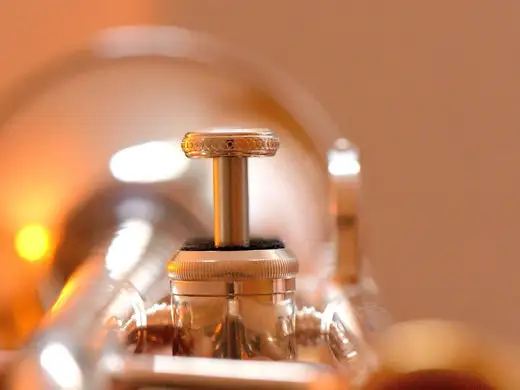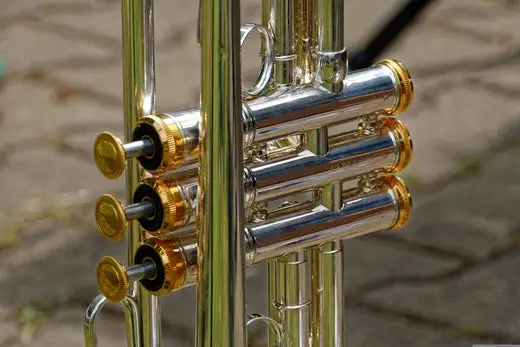Starting the Trumpets
As one of the flagship sections of the band, a good trumpet section can set the tone for the rest of the ensemble. This article addresses how to identify and cultivate beginning talent on the trumpet.
If you are a new director, and particularly if trumpet is not your primary instrument, you may find that these step-by-step instructions provide you with some structure and guidance as you begin to develop your own routines and methods. If you are a more seasoned director, the ideas in this article may complement and add to your existing repertoire.
CHOOSING YOUR TRUMPET SECTION
The first step in helping students choose an instrument is assessing their physical characteristics. This part of the process can be sensitive for some directors, who feel that it implies that students may not “be able” to play the instrument they hoped to play. However, ignoring students’ physique is ultimately selling them short, since they will experience the most success when their instrument is a good match for them.
The ability to form a working embouchure and produce a consistent buzz is a good sign that the student is well suited to the trumpet. If they have difficulty with formation and buzzing or are not ideally suited to the instrument in other ways, you can help them make a fully informed choice, while respecting and supporting whatever decision they make.
The guidelines in this section will give you something to look for on instrumental choice night, when the students have an opportunity to find out if the trumpet is a good fit for them.
Dental characteristics
Examine the student’s dental structure. If a student has any front teeth that are protruded, sideways or missing, the student may be limited in their comfort and embouchure development if they are unable to make the necessary adjustments. While there are many famous players who have irregular teeth, each student will need to overcome these idiosyncrasies in order to develop correctly, and some problems will cause greater frustration than others.
It is not unusual for the student to have an overbite or underbite, which will create unevenness in mouthpiece pressure and lip vibration. This unevenness will tend to impede embouchure development, sound production and endurance. An extreme overbite or underbite will greatly hinder their chances of being successful at the instrument.
If a student with irregular dental structure chooses to play the trumpet, they should begin private lessons as soon as possible. A good teacher can help the student balance their embouchure and mouthpiece placement. For example, students with an overbite may need to push the lower jaw forward to create a more balanced playing surface and correct the direction of the air flow.
Shape and size of the lips
Students’ lip characteristics will affect their success on the trumpet, and will also determine which mouthpiece is most suitable for them. While there is some individual variation in mouthpiece preferences and lip characteristics, there are a few general guidelines that teachers can use to help students get started. While the 7C or 5C mouthpiece is the most common for beginners, the mouthpieces referred to below (Bach sizes 5B and 10 ½ C) should also be available during the screening process for students with different lip sizes, so the teacher can identify the best fit. This way the student can purchase the appropriate size when they go to rent or buy their instrument.
Students with larger lips will be more comfortable on a mouthpiece with a wider inner rim (the open center of the mouthpiece), such as the Bach 5B. A large inner rim will allow the student’s lips room to vibrate, while an inner rim that is too narrow will pinch into the fleshy part of their lips, causing issues in tone, aperture flexibility, and endurance. While many directors may suggest trombone or tuba for students with very full lips, these students can be excellent trumpeters with the correct set-up and mouthpiece.
While students with slightly thinner lips can play a standard 7C mouthpiece, players with extremely thin lips should choose a mouthpiece with a narrower inner rim, such as Bach 10 ½ C. If the rim is too large, the students will have to use additional mouthpiece pressure to make the lips vibrate, and the mouthpiece will demand more embouchure strength than they have. The result will be soreness and poor endurance.
Some students may have a teardrop lip, in which the front part of the lip comes down further than the rest of the top lip. Since this lip formation can lead to an unreliable response, fluttering in the sound, a downward air stream, and aperture control issues, the teardrop lip is generally not well-suited to the trumpet.
If a student with a tear-drop lip has their heart set on playing trumpet and understands the difficulties associated with their lip shape, private lessons can help them develop strategies to minimize its impact on their playing. Since there are several techniques the student will need to use in establishing a good, working embouchure, early tutoring will be crucial to their success.
The Schilke 13C4 can be a good mouthpiece choice for students with a teardrop lip. It is comparable to a Bach 3C, but it has more rim surface area and is slightly more flat, helping to stabilize the teardrop portion of the lip. Its more funnel-shaped cup also allows the lips room to vibrate.
Testing embouchure and buzzing
To assess a student’s aptitude, you want to assess their control over their lip muscles and their ability to use their airstream effectively.
To form the embouchure, have the student make the sound “emmm.” Tell them to keep their corners firm and set. Next, have them push air rapidly through the opening, as though they are trying to blow a piece of rice off their lip. The air should be fast and centered. (If their lips do not vibrate, the student may be holding or stretching them too tightly, or they may need to blow faster air.)
Have the student hold the embouchure for several seconds to establish muscle memory, then relax the position. Now, have the student form the embouchure a second time, to see if they can remember what they did. If they are able to reproduce the lip position on their own and make a buzz without great difficulty, this is a sign that they have good control over their facial muscles and airstream.
After assessing the embouchure, walk the student through how to hold the instrument and sit correctly, so that you can assess whether the trumpet will be too heavy or awkward for them. Make sure you have a cornet available for them to try, since it may be a better fit, allowing them to (eventually) play the trumpet they had their heart set on. The next section discusses the advantages and disadvantages of starting individuals or even the entire class on the cornet.
STRUCTURING THE BEGINNERS’ CLASS
Having made an assessment of which students will be a good fit for the trumpet section, the way they start off the year with you is an important precedent to the success of the individual student and class. Beginning with high energy and rapid improvement will ensure that their first year is a productive one. Their success in the first months of playing will set the tone for the rest of their years in band.
Should they study cornet or trumpet?
The main difference between a cornet and a trumpet is the way they are wrapped – the length of tubing is the same for a cornet and a trumpet pitched in the same key. However, the cornet is wrapped in larger loops, shortening the distance from mouthpiece to bell and making it more compact than the trumpet.
Which instrument is better for a beginning student? There are several factors to consider, and you are in the best position to make a good decision for the students for the group. While a decision can be made on a per-student basis, there are also advantages to starting out the entire beginning class on the same instrument so they have a shared experience and shared technical challenges.
Advantages of beginning on the cornet include:
• The weight of a cornet is closer to the body, making it easier for younger or smaller students to hold. This can encourage better posture, and is preferable to allowing a student to struggle with the weight and balance of the trumpet.
• Cornets have a warm, mellow sound, and can be easier for young players to hear and tune.
• Since the instrument is shorter, the sound is perceived closer to the student’s ear, so they may feel slightly more in control.
• The cornet is more agile and responsive than a trumpet.
Disadvantages of beginning on the cornet include:
• The trumpet has a different feel and responsiveness than the cornet. When they change to trumpet after the first year, they will need to adjust to the different instrument.
• Possible feelings of isolation or self-consciousness, if there is a small minority of cornet players in a mixed class.
The trumpet is the chosen instrument for most band and orchestra literature because of its brilliant sound. Once the student has a good start on the cornet in terms of tone production and basic technique, they should transition to trumpet if they are physically mature enough to do so. This transition should happen by the end of the first year of study if possible.
Choosing a mouthpiece
Most beginners start out with a 7C or 5C mouthpiece (Bach numbering system). The 7C rim is not too narrow or too wide for most beginners, whose embouchure has not yet developed. The 5C has a wider inner rim, and can be used for students who already have better than average embouchure strength.
Students with larger lips will usually be more comfortable on a wider inner rim to allow for better lip vibration. Students with thinner lips tend to prefer a mouthpiece with a narrower inner rim to help with endurance and sound production. Ideally these students should be identified and set up with the correct mouthpiece during the screening process (see above).
While the Bach numbering system is commonly used as the standard, other brands may be more common in the beginning classroom, and the numbering will vary by manufacturer. The side of any mouthpiece should be stamped with a size. The table below references Yamaha and Denis Wick mouthpieces to the Bach numbering system; other references are available online.
In the Bach mouthpiece numbering system, the inner rim circumference gets smaller as the numbers increase. As the letters get smaller, the cup or bowl increases in depth.
Mouthpiece Comparison Chart
| Bach Numbering | Denis Wick | Yamaha Numbering |
| 1C | 1 | TR17C4 |
| 1 ½ C | 2W | TR16C4 |
| 1 ¼ C | 2 | TR17B4 |
| 2C | 3 | TR15C4 |
| 3C | 4 | TR14B4 |
| 5B | 4 | TR14D4 |
| 5C | 4C | TR14C4 |
| 6C | 4C | TR13B4 |
| 7C | 4B | TR11C4 |
| 10 1/2C | 5 | TR8 C4 |
Teach trumpeters together
If the school band program is large enough, it is extremely useful to have a full period each day dedicated exclusively to the beginner trumpet students (this strategy is useful for other sections as well). When classes are composed of several instruments, it is difficult for the teacher to spend individual time working with each student – although having a well-established private lesson faculty on campus can help to fill the gaps in this situation. Having developed facility on their instrument in the smaller classes during their first year, the students will be ready to make the transition to a full ensemble experience in seventh grade, allowing both the students and teacher to have a more satisfying experience.
Keep mirrors handy
During the first few weeks of beginner class, have the students watch themselves closely in a mirror while practicing embouchure set-up, lip buzzing, and mouthpiece buzzing. Include a locker mirror on the list of materials students are required to purchase for band class. The mirror should be placed on their music stand. With this constant reinforcement, the students will be able to self-correct many times without you needing to badger them. For their home practice, in addition to their locker mirror, a full body length mirror is beneficial for maintaining good posture and trumpet angle.
BEGINNING THE FIRST YEAR OF STUDY
With the advantage of having a class dedicated to your beginning trumpeters, setting them up well can be a clear, straightforward process. The following steps outline the first month or so of study, when the students will form the habits that will stay with them through the rest of their playing careers.
- Embouchure set-up The first few classes should focus on embouchure work alone, without the mouthpiece. Have the students concentrate on what a good embouchure looks and feels like. Once the students have a good embouchure, introduce the mouthpiece. Spend some time experimenting with the proper mouthpiece placement. Occasionally, a “proper” mouthpiece placement will cause discomfort due to differences in a student’s lips or dental structure. Students with these characteristics will need extra help in establishing a placement that works for them. Once the proper mouthpiece placement has been established for each student, have them practice placing the mouthpiece in the same spot many times in a row. The repetition will help them form this habit correctly, taking advantage of muscle memory.
- Lip buzzing Lip buzzing (or free buzzing) means forming an embouchure and buzzing without the mouthpiece. Lip buzzing helps the students build strength, firm corners, and embouchure and aperture control. Have the students strive for a consistent and resonant sound. You can start the buzz on the A below middle C. Have them do four counts of buzzing and four counts of rest. Since lip buzzing requires a good amount of embouchure strength to hold, limit lip buzzing to 2-3 minutes each class period – just enough to wake up the lips at the beginning of class. Too much lip buzzing can cause fatigue, ultimately leading to the opposite result of the one you want – broken-down corners and a weak embouchure.
- Mouthpiece buzzing and articulation Next, have them buzz the mouthpiece with no tongue attacks at first, using their non-dominant hand to help keep them from using excessive pressure. Let the students know that the mouthpiece is only an amplification of their lip buzzing. All the same principles apply. Without fast air, there are no vibrations to create the buzz. (They will quickly realize this through trial and error.) Once they are able to buzz easily using fast air, the students are ready to learn the basics of articulation. Have the students practice saying the syllable “tou” (pronounced like “two”) four times in a row, making sure their tongue strikes the roof of the mouth right at the back of the teeth (the alveolar ridge). Once they have found the correct tongue placement, have them perform the following exercise, performed without stopping between steps, with the metronome on at all times. Each step (including the resting periods) will occupy four beats.
- Vocalize a whole note beginning with “tou”
- REST
- Lip buzz a whole note beginning with “tou”
- REST
- Vocalize into the mouthpiece a whole note beginning with “tou” (but without buzzing).
- REST
- Buzz into the mouthpiece beginning with “tou”
In addition to developing a consistent, steady air stream, students should learn during this stage how to time their breath intake with the beat count. You should count the beats out loud, tell them in advance how many counts to sustain the note, and precede each of their entrances with the instruction, “breathe,” on the appropriate beat preceding their entrance.
So, for example, an exercise with four beats of rest and four beats of sustaining would sound as follows:
“One, 2, 3, breathe, play, 2, 3, 4. Rest, 2, 3, breathe, play, 2, 3, 4.”
For faster tempos and extended phrases, their breath will need to occupy two counts. The students are ready to learn at this stage that the important thing is breathing in time with the musical beat, and that the timing of their breath will be affected by the tempo of the piece and the length of the phrase.
Throughout this stage, also have the students mouthpiece buzz sirens so they can begin to use their embouchure muscles to control the size of their aperture. The sirens are fun for them, and they won’t even mind that they’re developing their range at the same time.
Have the students work solely on their mouthpiece for approximately one week, eventually buzzing short, familiar songs. This begins their ear training and gives them a sense of accomplishment at playing a recognizable tune.
STAGES OF THE BEGINNING TRUMPET CLASS
| 1 | Embouchure | 2-3 classes | Visual embouchure checks; lip buzzing, aperture control exercises. |
| 2 | Embouchure, with mouthpiece | 2 classes | Personal mouthpiece placements on the embouchure for each student; exercises memorizing mouthpiece placement. |
| 3 | Mouthpiece buzzing | 5 classes | Hold mouthpiece with non-dominant hand. Buzz long tones; familiar, simple tunes; buzz sirens; articulating “tou” syllable. Students should mimic the rhythm and pitch of the teacher until notation is introduced. Teach proper playing posture while sitting. |
| 4 | Trumpet introduction | 5 classes | Hand placement, correct sitting posture and trumpet angle. Play low C, D, E, F, and G on long tones. This is the last step before moving to the method book. |
Moving to the Trumpet
After the student has established a good sounding buzz on their mouthpiece and their setup is starting to be second nature, add the trumpet into the mix. This is the first time they have gotten to make sounds on the trumpet after several weeks of preparation, so this will be exciting for them.
First, show them how to hold the trumpet, and check each student’s hand position and posture. This is also a good time to introduce basic care and assembly of the instrument.
The class should start on either middle G or low C. Both notes are easy to produce and don’t require fingering, so that the students can focus on the sound alone. Once all the students have a correct setup, have them play four beats of G (or C) followed by four beats of rest.
Let the students know that the trumpet simply amplifies everything they have done on their mouthpiece. Make sure they are still blowing fast air and that the embouchure they have practiced remains identical. Do not have them use a tongued articulation during this first class. Their focus needs to be directed on using fast air, without any additional complications.
In the next class, teach them the scale steps between G and C using the valves, beginning with the note that was first learned. Continue checking posture and embouchure and practice the notes they have just learned. Articulation should be added back in at this point.
Beginning on the first day with the trumpet, and from then afterward, have the students play long tones just like they did on their mouthpiece. Playing long tones helps develop their embouchure strength and muscle memory, as well as their ear. Have them begin to work with the metronome in their own private practice, so they consider the metronome to be a basic practice tool.
The teacher does not need to emphasize intonation too much during the first several weeks of playing. Good sound production and breath support are much more important during this stage.
The only exception to this is the bottom space D (and eventually low C#). The students should learn these notes as 1-3 and 1-2-3 respectively, with the third valve slide extended. For all they know, the note can’t be played without the slide extended.
Once students have reached this stage, they are ready to begin working out of their method book.
Keeping the Ball Rolling
In starting off the year with a fresh group of bright-eyed trumpet players, it makes a difference if the teacher sets a supportive environment that also provides them with a level of challenge and high expectations, to keep them excited and stimulated. Below are some specific tips that can help establish beginners’ success throughout the first year.
- Establishing Models for Their Sound: Quite often, the only sound a student has to emulate is the student sitting next to them in class. They are the person they hear the most, so it is easy for them to be accustomed to their own practice-room struggles instead of striving for something better. A CD or DVD presented during class can quickly give them something else to aspire to, giving them a model of a smooth, clear sound and accuracy. In addition to providing them with a model of how they should sound, recordings help motivate students to put in long hours on the instrument, since they now have a goal in mind. The valuable class time will be more than paid back in increased practice time and motivation. While Miles Davis, Louis Armstrong, Maurice Andre or Wynton Marsalis may inspire particular awe from the students, your own demonstration during trumpet class has an immediacy for the students that is equally helpful. You are the best available role model for both sound and correct technique, and even if the trumpet is not your primary instrument, you can provide a needed role model during this early stage.
- Group Warm-up and Warm-down: Doing a group warm-up and warm-down (long tones in the lower register, in order to restore good circulation in the lips) allows the teacher to ensure that each student is doing these activities as they should. In addition to reinforcing the value of the warm-up and warm-down, it will begin and end the class in a calm, orderly way and avoid some of the chaos and competition that students inevitably engage in.
- Metronome: There should be very few times the metronome is not running during band class. If the students are playing, the metronome should be loud enough for them to hear, so that they begin to internalize the sense of beat.
- Weekly Playing Test: A weekly playing test gives the students a short-term goal to reach each week. They also get a chance to hear their classmates play, which helps them benchmark their own performance in comparison with their peers – something which will naturally occur, and which can be constructive and motivational if it is done in a supportive way under the teacher’s guidance. This is also an opportunity for the teacher to provide constructive feedback directly to the student. The performance experience need not always be graded, although it can be. Have the students play for one another in other contexts as well, such as demonstrating something positive or remedying an individual issue. Small performance opportunities allow the students to be “on stage,” and deal with the emotions that accompany performing. Students will be more comfortable with performing if it is part of their experience from the beginning.
- Private Lessons: If possible, private lessons should be made available during the first-year trumpet class or the full-ensemble class, as well as before or after school. Private teachers can structure their schedule so that most lessons are accomplished during regular working hours, with relatively brief (20-30 minute) lesson slots. The arrangement is convenient for students and parents, who do not have to sacrifice valuable evening and weekend time. Teachers can set the expectation that most students will participate in the affordable lesson program. Private lessons quickly raise the whole band program to a much higher level.
- Mouthpiece Transitions: As students gain embouchure strength over the course of their middle school study, they will need to increase their mouthpiece size at least once, and possibly twice. They may make one more size increase during their high school years, but most of this stepping-up should happen during middle school. The teacher may suggest that a student move to a larger mouthpiece when the student is performing consistently, accurately, and with a good tone. The change should be delayed if the student is currently involved with any technical challenge that would prevent them from devoting time to the adjustment. Thin-lipped students who began with a 10 ½ C mouthpiece will move to a 7C and then to a 5C. Students beginning on 7C should move to 5C, then possibly to 3C. Fuller-lipped students beginning on 5B should move to 3C and possibly to 1C or 1B. For younger students, a good trial period for a new mouthpiece is one to two weeks. While it is normal for a student to experience a reduced range and endurance initially, you should not observe any other negatives resulting from the transition. The student should feel physically comfortable and have a fuller sound. A beginning player may take as long as a month to fully adjust to a mouthpiece change, but progress should be evident during the first week and a half if the student is practicing consistently. Students should spend extra practice time on long tones, paying special attention to correct embouchure and set-up. The old mouthpiece can be donated to the band or traded in to the music store after the transition period is over.
Transitioning to Large Ensemble
With all the components above in place, the students have all the tools they need to transition smoothly into their full ensemble beginner band or seventh grade band.
Your students should be prepared to not receive as much individual attention now as they did in their individual instrument classes. They may go through a stage of feeling neglected or forgotten about; however, in time they realize they are now part of something bigger and rise to the occasion. Continuing in the private lesson program also gives them the individual attention and performance enhancement they need to play and participate at an above average level.
In the full ensemble, the students will be playing music with greater division among instruments, rather than having the melody all the time (which is an enjoyable part of the first year of playing). With encouragement from you and their older peers, they will discover that the enjoyment they receive now is connected to the excellence of the group as a whole, and to the knowledge that they are contributing their own best playing.
Having established good relationships with your students during the first year, and having gained their trust in you as a teacher and musician, your students will know you are there to help them through the rest of their band experience, in middle school and beyond.







